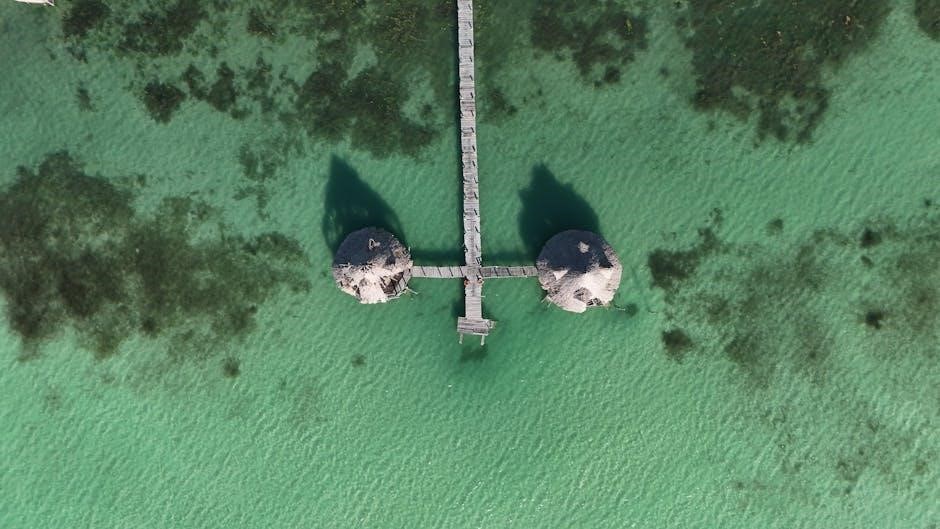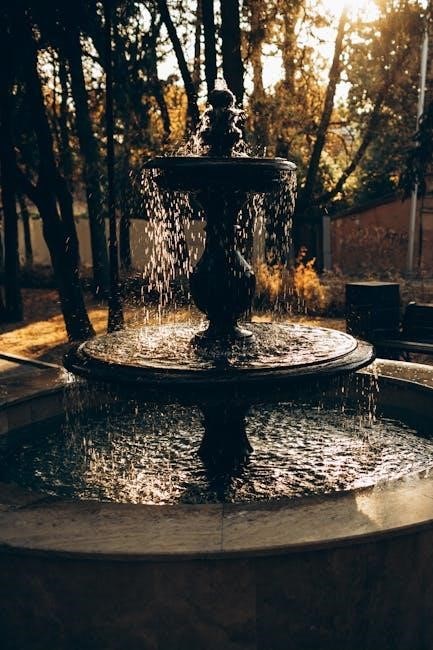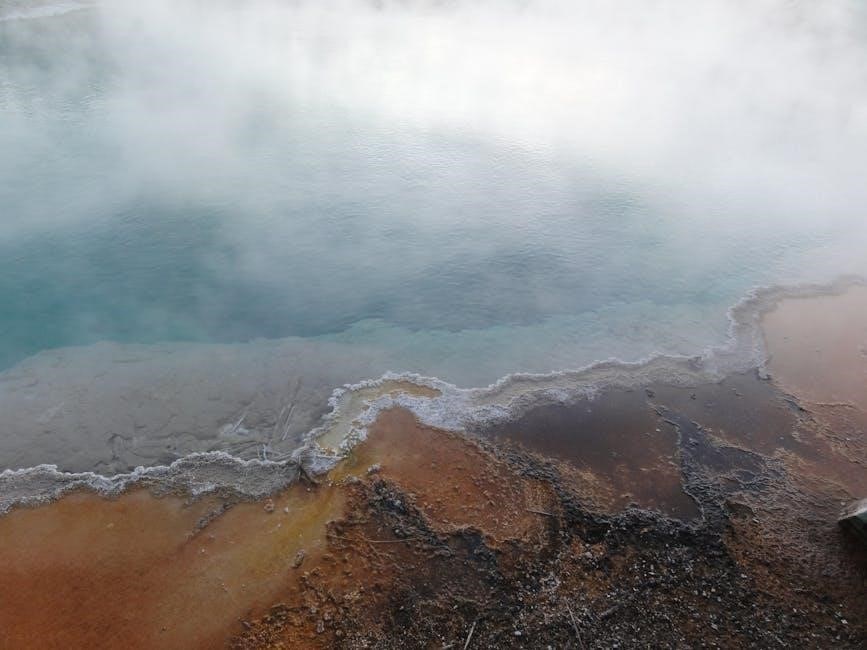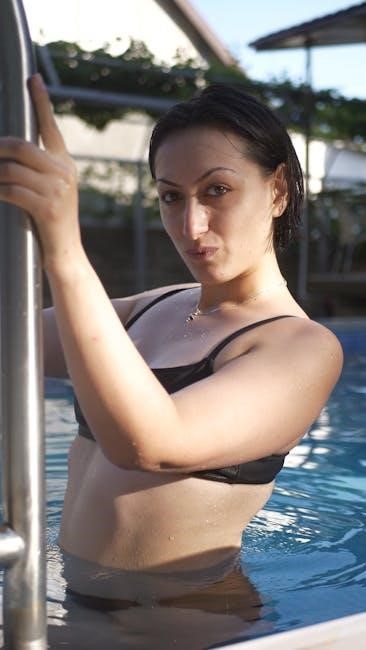A salt water pool offers softer water, reduced eye irritation, and lower chlorine levels, making it a popular choice for homeowners․ Regular maintenance ensures optimal performance, safety, and longevity of your pool system․ This guide provides essential tips and routines to keep your salt water pool clean, balanced, and enjoyable year-round․ By following these steps, you can maintain proper water chemistry, extend equipment life, and create a refreshing swimming experience for everyone;
Benefits of Salt Water Pools
Salt water pools offer numerous advantages over traditional chlorine pools, making them a popular choice for many homeowners․ One of the most significant benefits is the reduced irritation to skin and eyes, as salt water is gentler than harsh chlorine․ This makes it ideal for swimmers with sensitive skin or allergies․ Additionally, salt water pools produce chlorine naturally through a saltwater chlorine generator, eliminating the need for manual chlorine additions and reducing the strong chemical smell often associated with pools․
The smooth, silky water in salt water pools is also easier on hair and swimwear, extending the life of swimsuits and pool accessories․ Furthermore, the reduced maintenance requirements and automated chlorine production make salt water pools a convenient option for long-term ownership․ Overall, salt water pools provide a more enjoyable and healthier swimming experience compared to traditional pools․
Why Choose a Salt Water Pool?
Choosing a salt water pool is a decision that combines luxury, comfort, and practicality․ These pools are increasingly preferred due to their ability to provide a softer, gentler swimming experience compared to traditional chlorine pools․ The absence of harsh chemical odors and irritants makes them ideal for families, especially those with children or individuals with sensitive skin․
Salt water pools also require less manual maintenance, as the saltwater chlorine generator automates chlorine production, reducing the need for frequent chemical additions․ This convenience, combined with the long-term cost savings on chlorine products, makes them a financially attractive option․ Additionally, salt water pools are known for their modern aesthetic and ability to enhance the value of a property․ For those seeking a more natural and enjoyable swimming environment, a salt water pool is an excellent choice that balances health, convenience, and beauty․
Understanding Salt Water Pools
Salt water pools use a saltwater chlorine generator to produce chlorine naturally, eliminating the need for manual chlorine addition․ They offer a gentler swimming experience and lower maintenance compared to traditional pools․
What is a Salt Water Pool?
A salt water pool is a swimming pool that uses a saltwater chlorine generator to sanitize the water instead of traditional chlorine tablets or liquid chlorine․ While it still uses chlorine to clean the water, the process is different from conventional pools․ The generator converts dissolved salt into chlorine, creating a natural and gentler sanitizing process․ Salt water pools are known for their softer water, which is easier on skin and eyes, and they reduce the need for harsh chemical additives․ The salt level in these pools is much lower than seawater, typically around 3,000-6,000 ppm, making it barely noticeable to swimmers․ This system provides a more comfortable swimming experience and reduces the strong chlorine smell associated with traditional pools․ Despite the higher initial cost of the generator, salt water pools often require less maintenance over time․
How Salt Water Pools Differ from Chlorine Pools
Salt water pools differ significantly from traditional chlorine pools in their sanitizing systems and water chemistry․ Unlike chlorine pools, which rely on manually added chlorine tablets or liquid chlorine, salt water pools use a saltwater chlorine generator to produce chlorine naturally․ This process results in lower chlorine levels and softer water, which is gentler on skin and eyes․ Additionally, salt water pools eliminate the strong chemical smell often associated with chlorine pools․ Maintenance routines also vary, as salt water pools require regular monitoring of salt levels and generator function rather than frequent chlorine additions․ While both systems aim to sanitize the water, the salt water system offers a more natural, comfortable, and longer-lasting solution․ The initial investment for a saltwater system is higher, but it often leads to lower chemical costs over time․

Essential Components of a Salt Water Pool
A salt water pool system includes a saltwater chlorine generator, salt cell, pool finish, and control panel․ These components work together to maintain clean, sanitized water effectively․
The Role of the Saltwater Chlorine Generator
The saltwater chlorine generator is the heart of a salt water pool system, responsible for converting salt into chlorine to sanitize the water․ It eliminates the need for manual chlorine addition, reducing maintenance and potential chemical imbalances․ The generator uses electrolysis to break down salt molecules, producing chlorine gas that disinfects the pool․ This process creates a steady supply of sanitizer, ensuring clean and safe swimming conditions․ Regular monitoring of the generator ensures optimal performance, while proper maintenance extends its lifespan․ Unlike traditional chlorine pools, the generator provides a consistent and efficient sanitizing process, making it a key component for maintaining water quality and swimmer comfort․

Importance of Salt Levels in the Pool
Maintaining proper salt levels in a salt water pool is essential for its functionality and longevity․ Salt serves as the primary source for chlorine generation, and imbalanced levels can disrupt this process․ Low salt levels may reduce chlorine production, leading to improper sanitation, while excessively high levels can damage equipment and cause corrosion․ The recommended salt level typically ranges between 2700 and 3000 parts per million (ppm), depending on the manufacturer’s guidelines․ Regular testing ensures the salt concentration remains within this optimal range․ Additionally, proper salt levels help maintain swimmer comfort by mimicking the natural balance of seawater, reducing eye irritation and skin dryness․ Consistent monitoring and adjustments are critical to uphold water quality, equipment performance, and overall pool health․ Always consult your pool manufacturer’s recommendations for specific salt level requirements․
The Role of a Pool Finish in Salt Water Pools
The pool finish plays a critical role in salt water pools by providing a durable, non-reactive surface that withstands the corrosive properties of salt water․ Unlike traditional chlorine pools, salt water pools require specialized finishes that can resist erosion and staining caused by the saltwater environment․ Common finishes include quartz, fiberglass, and specialized plaster coatings designed for saltwater systems․ These materials help protect the pool shell from damage and ensure long-term structural integrity․ A compatible finish also prevents the leaching of harmful substances into the water, maintaining swimmer safety and water clarity․ Proper selection and installation of the pool finish are essential for the pool’s aesthetic appeal and functional performance․ Regular inspection and maintenance of the finish are recommended to prevent issues like etching or discoloration, ensuring the pool remains both beautiful and durable for years․ Always choose finishes specifically designed for salt water pools to avoid premature degradation․

Weekly Maintenance Tasks
Regular weekly tasks ensure optimal pool performance․ Test pH and free chlorine levels, clean the pool filter, and skim debris from the surface․ Check the saltwater chlorine generator and maintain proper salt levels for consistent sanitization․
Testing pH and Free Chlorine Levels
Testing pH and free chlorine levels is a critical weekly task for maintaining a saltwater pool․ Proper pH levels (7․2–7․8) ensure swimmer comfort and prevent eye irritation․ Free chlorine levels (1–3 ppm) must be monitored to ensure effective sanitation․ Use test strips or a liquid test kit for accuracy․ High chlorine levels can cause skin irritation, while low levels may lead to contamination․ Saltwater pools generate chlorine through the salt cell, so regular testing ensures the generator is functioning correctly․ Adjustments may be needed to balance these levels, such as altering the generator output or adding stabilizer․ Neglecting these tests can lead to imbalanced water chemistry, potentially damaging equipment or promoting algae growth․ Regular testing is essential for maintaining a safe, healthy, and enjoyable swimming environment․
Cleaning the Pool Filter

Cleaning the pool filter is an essential weekly maintenance task for saltwater pools․ The filter plays a crucial role in trapping dirt and debris, ensuring clean water circulation․ Regular cleaning prevents clogging, which can reduce water flow and strain the pump, potentially leading to cloudy water or equipment damage․ Saltwater pools often use cartridge, sand, or DE filters, each requiring specific cleaning methods․ For cartridge filters, remove and rinse with a hose or soak in a cleaning solution․ Sand filters are cleaned by backwashing, while DE filters need their grids cleaned or replaced․ Cleaning frequency depends on pool usage, typically every 1–2 weeks․ Neglecting filter maintenance can impair the saltwater chlorine generator’s efficiency, leading to insufficient chlorine production and unsanitary conditions․ Always follow the manufacturer’s instructions to avoid damage․ Regular filter cleaning also helps maintain energy efficiency and prolongs equipment lifespan․
Skimming Debris from the Pool Surface
Skimming debris from the pool surface is a simple yet crucial weekly maintenance task for saltwater pools․ Floating leaves, dirt, and contaminants can quickly accumulate, clouding the water and putting extra strain on the filtration system․ Use a leaf skimmer or pool skimmer to remove debris regularly, ideally once a day or every few days, depending on pool usage and surrounding environment․ Neglecting this step allows debris to sink, potentially damaging the pool floor or clogging the filter․ Regular skimming also prevents algae growth and maintains water clarity․ For saltwater pools, clean water ensures the saltwater chlorine generator operates efficiently, producing the necessary chlorine to sanitize the pool․ Consistent skimming promotes a healthier swimming environment, reduces the need for harsh chemicals, and extends the lifespan of pool equipment․ Make it a habit to skim the surface as part of your routine pool care․

Monthly Maintenance Tasks
Monthly maintenance involves checking and adjusting salt levels, inspecting the salt cell for wear, and ensuring stabilizer levels are optimal for water chemistry balance․
Checking and Adjusting Salt Levels
Regularly checking and adjusting salt levels is crucial for maintaining a saltwater pool․ The ideal salt level typically ranges between 2,700 and 3,000 ppm․ Use a salt test strip or digital meter for accuracy; If levels are low, add pool salt (sodium chloride) gradually, ensuring it dissolves completely before retesting․ High salt levels may require partial draining and refilling with fresh water․ Proper salt concentration ensures efficient chlorine production by the saltwater chlorine generator and prevents corrosion of equipment or eye irritation․ Consistent monitoring helps maintain a safe and enjoyable swimming environment․ Always follow manufacturer guidelines for adjustments to avoid imbalances․ Regular checks prevent issues like reduced sanitizer effectiveness or equipment damage, ensuring optimal pool performance and longevity․ Adjustments should be made carefully to avoid sudden changes in water chemistry․
Inspecting the Salt Cell
Inspecting the salt cell is a critical monthly maintenance task for a saltwater pool․ The salt cell, part of the saltwater chlorine generator, is where electrolysis occurs to produce chlorine․ Over time, it can become clogged with scale or corroded, reducing efficiency․ Turn off the system before inspection․ Remove the cell and inspect for scaling or damage․ Clean it with a descaling solution if necessary․ If heavily corroded, replacement may be needed․ Regular inspections prevent costly repairs and ensure optimal chlorine production․ Always follow the manufacturer’s guidelines for cleaning and maintenance․ Neglecting the salt cell can lead to reduced pool sanitation and increased operational costs․ A well-maintained salt cell ensures smooth operation and extends the lifespan of your saltwater pool system․ Schedule inspections every month to keep your pool running efficiently and safely․ Proper care of the salt cell is essential for consistent water quality․
Adding Stabilizer (CYA) as Needed
Stabilizer, also known as cyanuric acid (CYA), plays a crucial role in saltwater pool maintenance by protecting chlorine from sunlight degradation․ Without sufficient CYA, chlorine levels can drop rapidly, reducing the pool’s sanitizing ability․ The ideal CYA level for saltwater pools typically ranges between 70-100 ppm․ To test CYA levels, use a test kit or take a water sample to a pool professional․ If levels are low, add stabilizer according to the manufacturer’s instructions․ CYA is usually added in granular form, which dissolves slowly in water․ After adding, allow the pool to circulate for 24 hours before retesting․ Proper CYA levels ensure chlorine remains effective, maintaining clean and safe water․ Regularly monitoring and adjusting CYA is essential for optimal pool performance and swimmer health․ Neglecting this step can lead to inefficient chlorine production and increased maintenance costs․ Always follow the recommended guidelines for your specific pool system․

Water Chemistry Balance
Proper water chemistry balance ensures saltwater pools remain safe and clean․ It involves maintaining pH, alkalinity, calcium hardness, and stabilizer levels to prevent issues like corrosion or cloudy water conditions․
Maintaining Proper pH Levels
Maintaining proper pH levels is crucial for saltwater pool maintenance․ The ideal pH range for saltwater pools is between 7․2 and 7․8, slightly higher than traditional chlorine pools․ Low pH levels can cause eye irritation and damage to equipment, while high pH levels may reduce chlorine efficiency and lead to cloudy water․ Regular testing is essential to ensure the water remains balanced․ Use a reliable test kit or test strips to monitor pH levels weekly, or more often if the pool is heavily used; Adjustments can be made using muriatic acid to lower pH or a pH increaser to raise it․ Avoid over-correction, as sudden fluctuations can stress the system․ Proper pH balance protects swimmers’ comfort, prevents corrosion of pool equipment, and ensures the saltwater chlorine generator operates efficiently․ Regular monitoring and adjustments are key to maintaining a safe and healthy swimming environment․
Understanding Total Alkalinity
Total alkalinity (TA) is a critical factor in saltwater pool maintenance, as it measures the water’s ability to resist pH changes․ It acts as a buffer, stabilizing the pool’s pH levels and preventing sudden fluctuations․ The ideal total alkalinity range for saltwater pools is between 80-120 parts per million (ppm)․ Low TA can lead to unstable pH levels, causing eye irritation and equipment damage, while high TA can result in cloudy water and scaling issues․ Regular testing is essential to maintain balance․ Use a reliable test kit to measure TA levels and adjust as needed․ If TA is low, add an alkalinity increaser; if it’s high, use a pH reducer․ Proper TA levels ensure a stable swimming environment, protect equipment, and maintain the efficiency of the saltwater chlorine generator․ Regular monitoring and adjustments are vital for optimal pool performance and longevity․
Managing Calcium Hardness
Calcium hardness is crucial for maintaining the stability and longevity of your saltwater pool․ It measures the concentration of calcium in the water, which helps prevent corrosion of equipment and etching of pool surfaces․ The recommended calcium hardness level for saltwater pools is between 200-400 parts per million (ppm)․ Low calcium hardness can cause the water to become aggressive, potentially damaging surfaces and equipment, while excessively high levels may lead to scaling or cloudiness․ Regular testing is essential to ensure balanced levels․ To adjust calcium hardness, use calcium chloride to increase levels and partial draining and refilling to decrease them․ Proper management of calcium hardness protects your pool’s surfaces, ensures equipment durability, and maintains water clarity․ Regular monitoring and adjustments are key to preserving the integrity of your saltwater pool system․

The Importance of Stabilizer (CYA)
Stabilizer, also known as cyanuric acid (CYA), plays a vital role in saltwater pool maintenance by protecting chlorine from sunlight degradation․ Chlorine tends to break down when exposed to UV rays, reducing its effectiveness as a sanitizer․ Stabilizer forms a protective bond with chlorine, ensuring it remains active in the water for a longer period․ This is particularly important for outdoor saltwater pools, where sunlight is a constant factor․ The recommended CYA level for saltwater pools is typically between 50-100 ppm․ Without sufficient stabilizer, chlorine levels can fluctuate, leading to inefficient sanitization and potential overuse of the saltwater chlorine generator․ Regular testing and adjustments are necessary to maintain optimal CYA levels, ensuring the pool water remains safe, clean, and properly sanitized․ Proper stabilizer management also helps prevent eye irritation and reduces the need for frequent chlorine replenishment․

Saltwater Chlorine Generator Maintenance
Regular maintenance ensures optimal performance and longevity of the saltwater chlorine generator․ Cleaning the cell and checking for wear are essential tasks․ Neglecting maintenance can lead to reduced efficiency and increased costs․

Regular Inspection of the Generator
Regular inspection of the saltwater chlorine generator is crucial for ensuring its efficiency and longevity․ Start by visually examining the generator and its components for any signs of damage, corrosion, or wear․ Check the salt cell for mineral buildup, which can reduce performance over time․ Ensure all electrical connections are secure and functioning properly․ Inspect the flow sensors and switches to confirm they are operating correctly․ Cleaning the cell periodically is essential to prevent scaling and maintain optimal chlorine production․ Neglecting regular inspections can lead to premature wear, reduced chlorine output, or even system failure․ Always refer to the manufacturer’s guidelines for specific inspection and maintenance recommendations․ Regular checks help prevent costly repairs and ensure your pool remains safe and clean․
Cleaning the Salt Cell
Cleaning the salt cell is a critical maintenance task to ensure optimal performance and extend its lifespan․ Over time, mineral deposits and scaling can build up on the cell plates, reducing efficiency․ Start by turning off the power to the system and removing the salt cell from the generator․ Soak the cell in a mixture of water and acid (such as muriatic acid) to dissolve the deposits․ Use a soft-bristle brush to gently scrub away stubborn scale․ Rinse thoroughly with fresh water to remove any residue․ Repeat if necessary until the cell is clean․ Allow the cell to dry before reinstalling it․ Regular cleaning prevents corrosion and ensures consistent chlorine production․ The frequency of cleaning depends on pool usage and water hardness levels․ Always follow safety precautions when handling acid, such as wearing gloves and working in a well-ventilated area․
Knowing When to Replace the Salt Cell
Knowing when to replace the salt cell is essential for maintaining your salt water pool system․ The salt cell typically lasts between 3 to 5 years, depending on usage, water conditions, and maintenance․ Signs that indicate the need for replacement include a significant decrease in chlorine production, increased cell cleaning frequency, or visible corrosion on the plates․ If you notice the system requiring more energy to produce chlorine or if the pool water becomes consistently imbalanced, it may be time to replace the cell․ Heavy scaling that doesn’t improve with cleaning is another indicator․ Always check the manufacturer’s recommendations for lifespan and replacement guidelines․ Upgrading to a new salt cell can improve efficiency and reduce long-term costs․ If unsure, consult a pool professional to assess the cell’s condition and recommend the best course of action․
